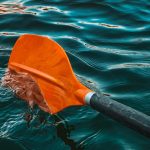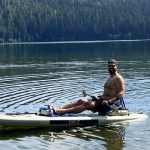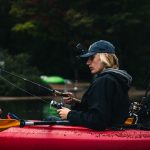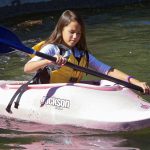Why the right size paddle board matters? From this guide you'll know everything necessary to find the paddle board best sized for you.

Summer is just around the corner, and you know what that means?
Paddle boarding season!
Warm weather and long, sunny days make for the perfect time to get out on your favorite lake, river, or beach to enjoy a few hours of paddling.
But before you head out to the nearest sports good store to buy a paddle board, it’s important to know how much a good stand up paddle board will cost–really, whether or not it’s an affordable addition to your summer fun.
Below, we’ll break down all aspects of paddle board costs so you’ve got a clear idea of just how much you can expect to spend on whatever paddle board you decide to buy, be it a cheap paddle board, inflatable paddle board, mid-tier hard paddle board, even a top-of-the-line racing or touring SUP board.
Whatever type of paddle board you’re thinking of buying, we’ve got the information you need to know.
So let’s dive right in!
Your Guide to Paddle Board Pricing: How Much You Should Expect to Spend on Paddle Boards

If you’re looking to make your first paddle board purchase, you might have zero idea how much you should spend on an SUP board.
Prices will vary according to a number of factors–everything from materials to design (we’ll get into greater explanation below)–so it can be hard to know how much a board can cost.
That’s what we’re here to talk about today.
Let’s break down how much you can expect to spend on a paddle board according to type first…
Inflatable Paddle Boards Cost
Inflatable paddle boards are some of the best entry level paddle boards because they’re typically less expensive than hard-shell (fiberglass, carbon fiber, and epoxy) paddle boards.
That’s largely due to the materials used in the construction, such as PVC. Reinforced PVC is durable, puncture-resistant, and (relatively) UV-resistant, but it’s less expensive than higher-end hard-shell materials.
Inflatable boards will usually start at around $400, though you can find some ultra-budget models online for as little as $250 or $300.

Bear in mind, though, that these will usually be constructed overseas, and may A) not be built as sturdy, and B) be built by companies that go out of business within 1-2 years. A paddle board you buy online today may no longer be available even within a few months because of the “here and gone” nature of some manufacturers/brands selling online/via Amazon.
Not all inflatable boards are going to be “budget” models, though. You can find quite a few inflatable SUPs in the $700 to $1,500+ price range. These retail for more for a few reasons:
- An advanced design. For example, the hybrid SUP design of the Isle Switch allows you to switch between a kayak (with seat and dual-headed paddle) and a standard SUP. Thanks to modern technology, there are even inflatable racing boards, fishing paddle boards, Yoga boards, and touring boards–though they tend to be more expensive than your average budget inflatable paddle board.
- More rugged construction. A lot of the top quality inflatable paddle board models will be made using drop-stitch construction–two parallel sheets of material joined together by hundreds (or thousands) of individual stitches. This makes for much tougher inflatable SUP boards far less prone to sagging, bending, wear, or punctures. Some boards also feature dual or even triple layers of PVC for even greater durability and rigidity.
- More accessories. Add-ons like a seat, electric pump, more advanced paddle design, and foam deck will all jack up the inflatable paddle boards cost.
For your money, an inflatable paddle board will be the most portable option, an excellent choice for anyone who wants a travel-friendly solution for getting out on the water at a moment’s notice. No roof rack or trailer needed; just a bit of trunk storage space and you’re good to go.
Hard-Shell Recreational/All Around Stand Up Paddle Boards Cost
You can find some hard paddle board models that are cheaper than the average inflatable paddle board–say, in the $200 to $400 price range. These stand up paddle boards will usually be designed for recreational (or all around) use.
However, bear in mind that they will be cheaper boards overall–not only in terms of materials used, but also construction and design.
For example, most of the cheapest hard paddle boards will be designed for flatwater paddling, but won’t have as high a volume/weight capacity as the higher-end models. Most will lack other convenient features of the higher end stand up paddle boards, such as a foam deck or EPS foam core.
If you don’t want a cheap paddle board, but are willing to pay slightly higher paddle board prices for a better quality board, you can find hard-shell recreational and all around paddle board models in the $500 to $900 range.
These may use more advanced materials (fiberglass, epoxy, or carbon fiber, for example), and will usually be wider, longer, and more stable overall.
However, they’re still among the cheapest options on the market–cheaper even than the better quality inflatable stand up paddle boards.
Surfing Paddle Board Cost

Surf SUP boards are designed specifically with surfing in mind. This means they’ll usually be hard boards that are shorter, narrower, lighter, and more agile, with less stability than your average recreational or inflatable stand up paddle boards.
Depending on the model, they may be crafted from wood (such as the Koa wood used to build the first paddle boards by the Hawaiian islanders who invented them), fiberglass, or carbon fiber. All high quality materials with a price tag to match.
With surf SUP boards, you can expect prices to start at around $1,000, and just go up from there. However, you’ll find there are plenty of high quality board designs and builds that won’t cost you too much money–any more than $2,000 is likely too much to spend on even a good board for SUP surfing.
Fishing Paddle Boards Cost
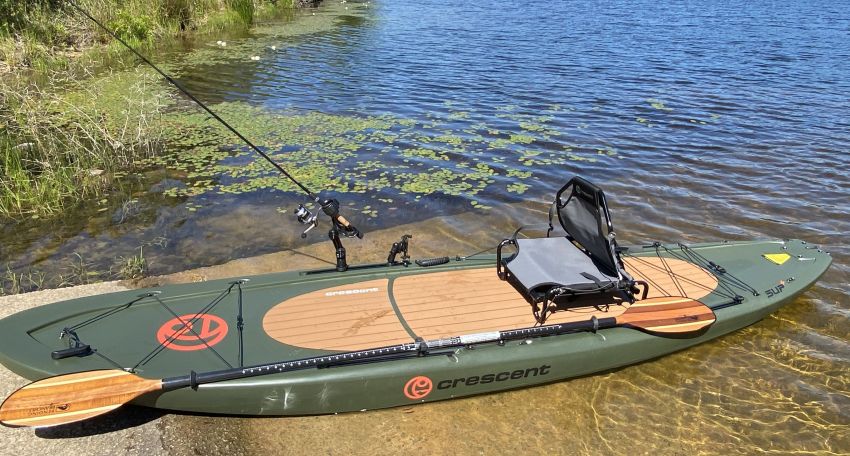
Fishing paddle boards, like fishing kayaks, will cost slightly more than recreational models. They need to be a bit wider, sturdier, and have a higher buoyancy than recreational paddle boards because they need to bear the weight of you, your fishing gear, and whatever you catch.
Thankfully, there are plenty of good-quality affordable inflatable SUPs designed specifically for fishing, which will run you around $500 to $800. If you prefer a hard-shell over an inflatable board, you’re looking at a price range starting at around $700 or $800.
For the real high-end SUP boards for fishing, though, you might spend as much as $2,500. These more expensive boards will feature a lot of fishing-specific accessories and design features, such as:
- D-rings
- Gear mounts
- Seat compatibility
- Rod holders
You can definitely get away with fishing on a cheap board. However, if you’re looking for a higher-end, purpose-built board where you can spend all day fishing in comfort with all the best conveniences, expect to spend a bit more.
Touring Board Cost
Touring boards are more “specialized boards”, designed with a very specific shape and structure that makes for more effective long-distance paddling across open ocean or large lakes.

A touring SUP is almost always going to be hard-shell, usually made from a lighter-weight material (like fiberglass or carbon fiber, though some use epoxy resin). These hard boards are also longer and sleeker, with a sharp nose and displacement hull that slices through the water faster. They also have higher secondary stability (ideal for navigating choppy ocean waters) and are built for more advanced paddlers.
No surprise, then, that they’re among the most expensive of the paddle board types.
The price for a touring SUP board starts at around $1,000 (give or take a few bucks). For the really high-end models, you’ll find the board price can rise as high as $2,000 or $3,000.
These are not cheap boards, neither in quality, design, nor construction. They are among the most cutting-edge paddle boards–and command a price tag to match.
Racing Boards Cost
Racing and touring SUP boards have a lot of design and construction features in common.
Typically, a racing board will be slightly longer than a touring SUP (by 6-12 inches), and may be slightly narrower (by 1-2 inches). They’re often built using the most lightweight materials around (almost exclusively carbon fiber and fiberglass) because less weight means less effort expended to paddle at full speed.
The price tag on these stand up paddle board models will also be roughly the same. Expect to pay no less than $900 or $1,000 for the “cheap” paddle boards for racing, or as much as $3,000 for the high-end models used by professional racers.
Whitewater Paddle Board Cost
Whitewater paddle boards are built for both agility and durability. They have to make sharp, tight turns and navigate fast-moving currents, but also need to survive a hard impact against obstacles or riverbanks.
Typically, they’ll be designed shorter and narrower than recreational paddle boards, which gives them greater maneuverability. However, where other high-end boards (like touring and racing SUP boards) are built using lightweight materials, whitewater paddle boards are constructed using the toughest materials around: epoxy resin and/or thermoplastic. These materials are slightly cheaper, making whitewater boards fractionally lower-cost than racing/touring paddle boards.
Whitewater paddle boards will start at around $800, but as you add more features (D-rings/tie-downs, rear kick pads, whitewater-specific fin, etc.) and more durable materials, the price can rise as high as $1,200 to $1,800 for a really great board tough enough to handle rapids.
Yoga Stand Up Paddle Board Cost
Yoga paddle boarding is one of the most popular recreational uses of paddle boards. In fact, it could be argued that Yoga paddle boarding is what gave rise to the recent surge of interest in paddle boarding as an activity.
When doing Yoga on a paddle board, you want a very stable board with high primary stability. A lot of Yoga boards will be epoxy boards, typically featuring an ultra-light EPS inner foam core that offers excellent buoyancy. They’ll usually have a soft, springy deck pad that provides cushioning for your feet, knees, hands, and elbows while you move between your asanas.
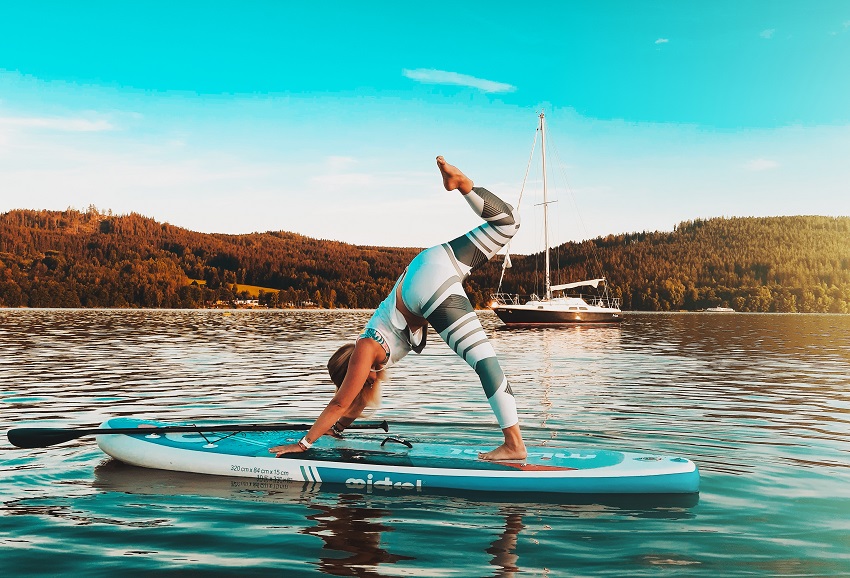
However, inflatable SUPs have become very popular for Yoga paddle boarding, too. Thanks to the high stability and buoyancy of an inflatable SUP, you have a much more solid platform on which to perform your Yoga poses.
Yoga paddle boards will be built longer and wider than recreational boards, with a higher weight capacity, too. This is very important if you’re on the larger, heavier, and taller side. For more “average-sized” or “compact-sized” people, though, many of the best cheap paddle boards are large and stable enough to use for Yoga.
If you’re going to start paddle boarding Yoga, the price range will start at around $500–both for a hard-shell and inflatable SUP. The more complex you get–a larger design, softer/larger deck pad, on-board storage, etc.–the higher the price will rise, up to as much as $1,300.
Kids Paddle Board Cost
It should come as little surprise to you that kids’ paddle boards are among the lowest-budget “cheap” paddle boards on the market. After all, kids don’t need a very high weight capacity or a long or wide paddle board body. What they do need, though, is a paddle board capable of standing up to the sort of rough handling to be expected from younger kids.
(As a father of four myself, take it from me: kids are NOT gentle on their toys! My now-grown adult sons still like to roughhouse and “paddle board joust” when we’re at the lake.)
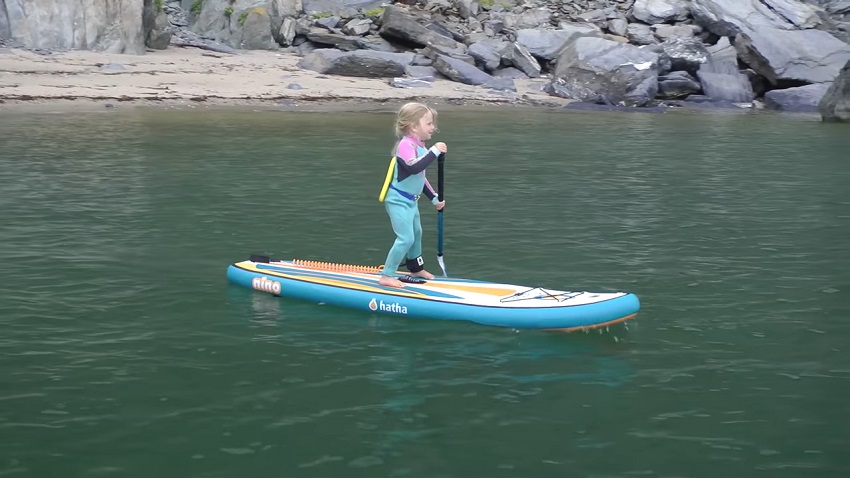
Typically, a stand up paddle board built for kids will be constructed from hard thermoplastic, a material that not even they can easily destroy. The lower-cost material and simple design makes for cheap paddle boards well-suited to active kids.
There are plenty of inflatable paddle boards built for kids, too. They won’t have the highest-tech features or most advanced design, but will simply be sturdy, practical, reliable inflatable paddle boards sold at a budget price.
If you’ve got kids you want to take paddle boarding with you, it’s best to start them off with a first board at the lower end of the price spectrum–in the $300 to $600 range common for budget models. As they grow more advanced or show greater interest in paddle boarding, you can look for a higher-end kids stand up paddle board. But spending any more than $1,000 on either hard-shell or inflatable paddle boards for your kids is only a good investment if they’re as dedicated to the activity as you are.
Kayak SUP Hybrid Cost
Kayak SUP hybrids are usually paddle boards that can be converted into kayaks–for example, by adding kayak seats and footrests secured to D-rings, and switching the paddle from a one-headed SUP paddle to a double-headed kayak paddle.
You can find kayak SUP hybrids as both hard-shell rigid boards and as inflatable paddle boards. Take, for example, the Isle Switch. I personally tested the stand up paddle board hybrid to see how it functioned as both kayak (paddling sitting down on a kayak seat) and SUP paddle boarding (paddling standing up). Not only was it one of the best inflatable paddle boards I’ve used to date, but it handled well in kayak configuration, too.
The fact that they’re created to handle well for both activity types does require a more advanced construction and design. They’ve got to be wide and stable enough to use for paddle boarding, but also mobile enough that you can handle them effectively when kayaking.
They’re not the cheapest of the stand up paddle board models; even the inflatable SUP kayak hybrid models will cost you at least $1,200.
But if you love both kayaking and stand up paddle boarding, it’s an excellent investment. One board to do both activities!
Buyer Beware: When Cheap Paddle Boards are too “Cheap”
When shopping for a paddle board–either hard-shell or inflatable paddle boards–you need to watch out for any deal that looks too good to be true.
Don’t get me wrong: I love a bargain as much as the next guy! You slap a “Special Discount” or “Limited-Time Offer” sticker on a paddle board, and you’ve got my attention.
But there’s cheap in terms of price, then cheap in terms of quality. The former is great, but the latter is something you want to avoid at all costs.
The best cheap paddle boards will still feature durable construction, a versatile design, and long-lasting materials. “Cheap” paddle boards will be more prone to break, malfunction, sag, bend, pop, or just stop working properly because they use lower quality materials or are assembled incorrectly.
Here are a few things to keep in mind when shopping for the best cheap paddle boards:
- Always read reviews. Before you buy any paddle board, take a few minutes to do your research. Read reviews to see what problems the board may have. Remember: inflatable SUP models are more prone to flaws/malfunctions than hard-shell boards.
- Be wary of suspicious sellers. Even on Amazon, there are retailers who offer the “best cheap paddle boards” at a price tag that’s too good to be real, but with no reviews on the product. Typically, that’s a sign they’re either scammy or a company that’s trying to move a ton of low-quality inventory quickly before they go belly-up.
- Try before you buy. If you’re buying from a bricks-and-mortar retailer, ask if you can take the board out for a test. Many will actually have “show models” that you can rent/test out to get a feel for how well they handle. If you’re buying from an online retailer, see what their return/exchange policy is. Especially with inflatable SUPs, you want to make sure you can get your money back in case the board is defective.
Don’t immediately buy the cheapest board in the store, else you risk getting a lower quality, less durable option. Sometimes, it’s worth spending more to find that “sweet spot” between affordability and reliability.
Factors Affecting the Cost of Inflatable Paddle Boards
The answer to the question “How much do paddle boards cost?” can be a fairly complex one, because the paddle board price is affected by a number of factors.
Below, we’ll look at each of the factors so you can have a clearer idea of how much you’ll have to spend according to what board quality you want…

Factor #1: Materials
We talked a little bit about board materials above, but I want to take a minute to dive a bit deeper into the various materials so you can understand how they can affect the price points of the various paddle board options.
There are a number of materials used in the construction of both hard board and inflatable SUP board models. I’ve listed them below based on cost:
Plastic
Plastic is the cheapest of the materials, as well as one of the most durable. Many of the low-budget hard-shell recreational and all around boards are made using plastic because of how tough it is.
Plastic is also used for many lower-end whitewater paddling boards. The durability of plastic is sufficient to withstand the impacts against rocks and other obstacles.
However, the weight of plastic means it’s usually too heavy to use for boards that need to be lighter, such as racing, touring, or surfing SUPs.
PVC/Polycarbonate
PVC is the go-to material for inflatable paddle boards, especially the cheaper boards. PVC is lightweight and puncture-resistant, but forms a rigid enough shell when inflated that it will serve you well.
Mid-range and higher-end inflatable SUP boards may also blend polycarbonate (a type of lightweight plastic) into the PVC to enhance durability.
Both PVC and polycarbonate are fairly light, which makes them the ideal materials for a portable, travel-friendly board.
Wood
Wood is the traditional material used by the Hawaiian islanders who first crafted paddle boards and used them to travel from island to island. Most wooden paddleboards are made with:
- Koa (a high-cost, “luxury” wood)
- Paulownia
- Pine
- Bamboo
- White Cedar
- any oil-rich wood, really
Typically, the wood is glued with epoxy resin, sometimes even covered with a layer of epoxy to add durability and shield the wood from moisture.
EPS Foam
EPS foam is typically used to craft the core of paddle boards. The foam is incredibly lightweight and contributes to the buoyancy of the board.
There may be plastic, PVC/PC, even fiberglass or carbon fiber wrapped around the foam core to create a solid shell capable of withstanding impacts and maintaining its shape.
Composite
Composite materials–including fiberglass and carbon fiber–make for a very lightweight board!
Carbon fiber is said to be “five times stronger than steel and twice as stiff”. Higher-end whitewater paddleboards are often made using this material because of its incredibly high toughness-to-weight ratio.
Sheets of fiberglass are often used to craft the shell of a board (around a foam core). When dried, fiberglass is one of the sturdiest, most durable materials on the planet. It’s also wonderfully lightweight.
Both materials are commonly used in the construction of racing, touring, and whitewater paddle boards.
They may be very pricey, but guaranteed to last for many years longer than even the best cheap paddle boards, and with far more intense/high-impact use.
(Note: For a more in-depth look at each of these materials, check out our post on Paddle Board Types, where I take a deep dive into the subject.)
Factor #2: Construction

The way a board is built will have a direct influence on its durability, as well as its performance.
- Solid Core hard-shell boards will be tougher and more resilient, less likely to break or bend. However, they’ll be much heavier.
- Hard-Shell boards with Foam Cores will be lighter-weight and have higher buoyancy, and with the right shell materials, will still be sturdy.
- Laminate boards made of up multiple layers of wood, fiberglass, or plastic will maintain their shape and structural integrity, but will weigh more than a foam-core board.
- Single-ply inflatable boards will feature a single thick layer of PVC sewn together to create the structure. These will usually be the cheapest of the inflatable SUP boards, as well as the weakest.
- Fusion inflatable boards feature the two single-layer PVC/PC sheets sewn together, but feature an extra layer of PVC encasing the outside to essentially provide a second layer of protection. These will be heavier, tougher, and more expensive than single-ply boards.
- Dual-layer inflatable boards feature an inner bladder made from a single-ply material, which is then laminated with PVC-coated fabric with adhesive layers between. They tend to be the toughest of the inflatable SUPs, but will both weigh and cost more.
- Drop-stitched boards use hundreds or thousands of individual threads to join the upper and lower layers of PVC, creating a board that is both incredibly stable and durable. However, the threads will add to the price and weight of the board.
Factor #3: Size

When talking about the size of your paddle board, I’m referring to both width and length.
To explain it simply:
- The longer a board is, the faster it will travel and the straighter it will track.
- The shorter a board is, the more agile and maneuverable it will be.
- The wider a board is, the more stable it will be.
- The narrower a board is, the faster and more maneuverable it will be.
As expected, longer and wider boards require more material to build, so they will typically be more expensive.
On the flip side, narrower, shorter surf and whitewater SUP boards will be pricier because of the high-quality, highly durable materials used in their construction.
(Note: For a more in-depth look at how size and weight affects your board’s performance, read my guide on How to Choose a Stand Up Paddle Board)
Factor #4: Weight
The weight of a hard-shell paddle board will be directly linked to its price. Why is that?
Simple: lighter-weight materials (like carbon fiber and fiberglass) are significantly pricier than heavier materials (like plastic). The lighter you want the hard-shell board to be (for racing, touring, or SUP surfing), the more you should expect to pay.
The same is true with inflatable boards, but for a very different reason.
Heavier inflatable boards are generally made from the same materials as lighter, cheaper boards, but they’re heavier because they have more layers, extra materials or adhesives, or drop-stitching. More material goes into the construction of the board, making it both tougher and heavier.
Factor #5: Weight Capacity

A paddle board’s weight capacity will be influenced by a number of factors:
- Materials (which affects its buoyancy)
- Width
- Length
- Thickness
A paddle board built for heavier paddlers will usually be longer, wider, and thicker than a board built for lighter paddlers. This means more material is needed in its construction, making it more expensive than other boards of a more “normal” size.
Factor #6: Accessories Included

Higher-end boards also often mean higher-end accessories, for example:
- Fiberglass/carbon fiber paddles rather than an aluminum paddle
- Motorized SUP pump rather than just foot/hand pump
- Addition of a kayak seat/footrest (in the case of hybrid SUPs)
- More D-rings and tie-downs
- Gear tracks and mounts
The more accessories that come included in the board, the higher the board will end up costing you.
Factor #7: Board Type
The type of board will determine its construction, which in turn will affect its cost.
For example, both racing and touring SUPs are built fairly same, but a racing board will usually cost more because it uses lighter-weight materials and a design specific for greater speed. A board built for touring, on the other hand, will be built to less exacting standards–it needs to travel long distances, but not at such high speeds.
Or, compare the sort of use a whitewater paddle board might endure compared to a surfing SUP board. One is built to withstand high-speed impacts with big, solid obstacles, as well as navigating fast-moving currents. The other is built for agility and maneuverability, but without as much need for durability. No surprise, then, that whitewater paddling boards will usually end up costing more though their design is fairly similar.
All of the factors above (materials, construction, size, weight, and weight capacity) will be taken into account for each type of paddleboard, and affect the cost accordingly.
How to Shop Smart When Buying Paddle Boards
Where to Buy Paddle Boards
There are a few places you can go shopping for paddle boards:
- Costco/Sam’s Club/Big Box Stores — These big stores will usually feature well-known paddle board brands (for example, Body Glove or Nautica), both inflatable and hard boards. These are good places to find cheap boards, often on sale weeks or months before the paddling season begins. However, bear in mind that the quality of the boards is often less-than-the-best because the store is focused on profit margin and low pricing for their customers.
- Walmart/Target/Big Retailers — Big retailers like Walmart and Target will usually feature even lower-end, more budget-friendly paddle board models than their wholesale competitors. You can find some great deals and highly affordable price tags, but don’t expect the boards to last for more than 2-5 years. And you’ll usually only find recreational and all around SUPs at these retailers.
- Dick’s/Academy/Big Five/Cabela’s/Sports Goods Stores — If you’re looking for more advanced types of boards, it’s a good idea to head to sport-specific stores that sell all types of paddle boards. You can check out kayak, canoe, and paddle board stores, stores that cater exclusively to water sports, or larger-sized sports stores like Cabela’s or Dick’s. You’ll have your pick of budget-friendly models, but you’ll also find a good selection of mid-range and higher-end models, too.
- Manufacturer Websites/Online Retailers — If you want top quality, the best thing to do is go directly to the manufacturers you know and trust (for example: Bote, Isle, SurfTech, Pau Hana, or Boardworks). These retailers will usually have special sales and discounts throughout the year (to save money), and you can always trust the quality of the boards you’re getting will be top-notch.
What About Shopping on Amazon?
If you’re looking to shop for SUPs on a budget, Amazon is the best place to go. There, you’ll find a host of affordable options, as well as plenty of mid-range and higher-end models, too.
One thing to know about Amazon is that many of the cheapest paddle boards will be manufactured and distributed by Chinese companies. As I mentioned above, it’s common for these brands to only be around for a few months (or years, tops) before going out of business or simply releasing new products under a new brand.
For this reason, most of the cheapest boards on Amazon won’t include much in the way of a warranty–usually a 90-day satisfaction guarantee or, at most, a 1-year warranty.
Thankfully, Amazon’s customer service department is there to help you handle any issues that may arise when buying a paddle board or dealing with returns/exchanges.
What Time of Year to Buy a Paddle Board
When you shop for paddle boards is often just as important as where you shop. If you’re smart, you can usually find great deals and discounts throughout the year!
Shop on Holidays
Typically, most retailers and manufacturers will have special deals on holidays. For example:
- 4th of July
- Memorial Day
- Black Friday
- Christmas
- New Year
These are a great time to be on the lookout for special promotional offers, BOGOs, or discounts on paddle boards.
Shop Just After Season’s End
Once the weather begins to get too cold to be out on the water, a lot of retailers will try to clear out the physical inventory taking up space on their showroom floor and in their warehouses in order to make space for the seasonal items they’re bringing in for the remainder of the year.
This is when they will often drop the prices on any paddle boards left in stock, that they couldn’t move during the warmer/summer months.
Shop in the Dead of Winter
It may sound counter-intuitive to buy a summer item in the dead of winter, but it’s actually quite effective–especially if you’re shopping online.
Most paddleboard/kayak/water sports companies are aware that there is always down-time during the winter months, so they’ll usually offer some sort of promotion, deal, or discount to move inventory during the slow “off-season”.
It’s worth regularly checking your favorite paddle board retailer, manufacturer, or website to see if you can spot a good price on a board you’ll use when summer rolls around. Even if it spends 3-5 months sitting in storage, it’s well worth saving a few hundred bucks on a great paddle board.
How Much Do Paddle Boards Cost? FAQs
Kayaks are actually easier to build than paddle boards. Their designs are simpler, with more room to make adjustments to the craft.
Building a high-quality, durable, versatile, high-performance paddle board requires more complex engineering/design, more labor-intensive manufacturing techniques, and costlier materials.
A good paddle board will retain its value for 10+ years with proper care and maintenance. A well-cared for board in good condition can be re-sold for easily 75 to 90% of its original retail price.
Cheap paddle boards are a decent investment for any newbie looking to enjoy one or two seasons out on the water, or to learn their way around paddling. However, once you get into more advanced paddling (on whitewater, touring, racing, surfing, even just paddling around bays or ocean inlets), you’ll find a low-budget paddle board might not be quite up to snuff. That’s when it’s time to upgrade and pay a bit more for a sturdier, more versatile, higher-performance board better-suited to your specific type of activity.



